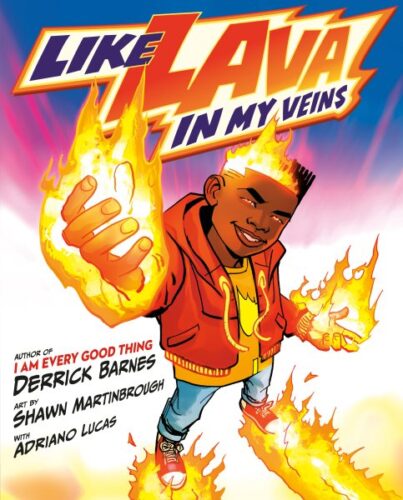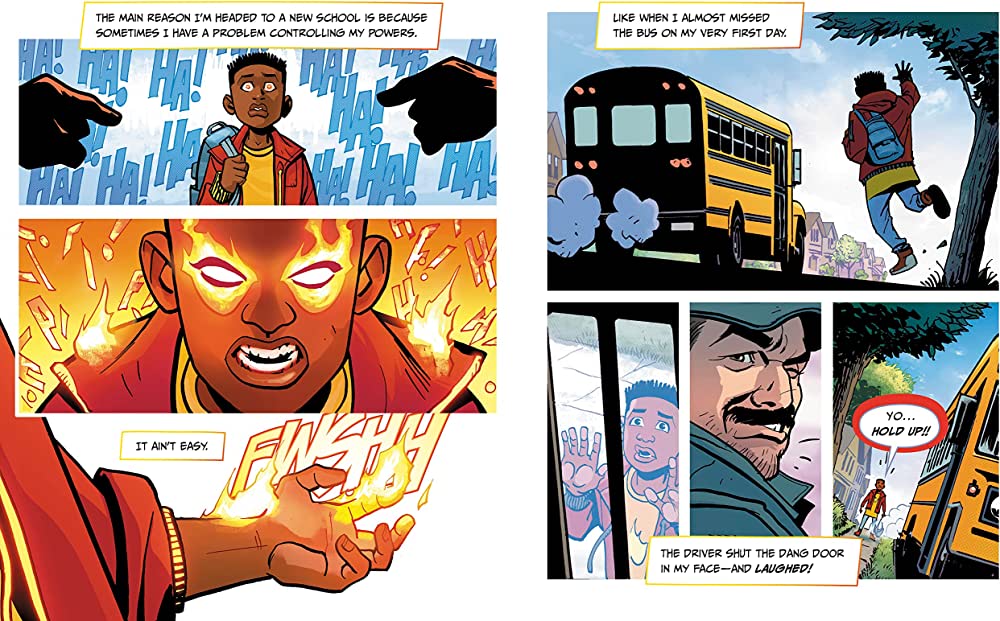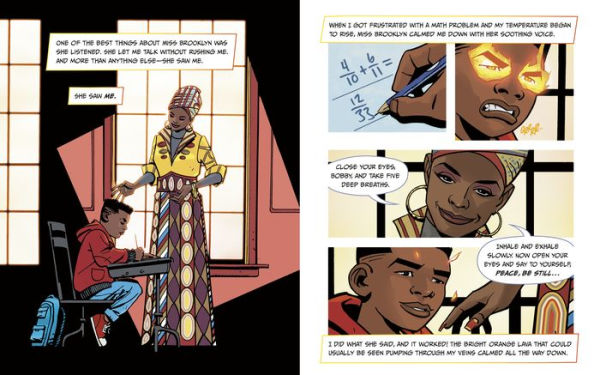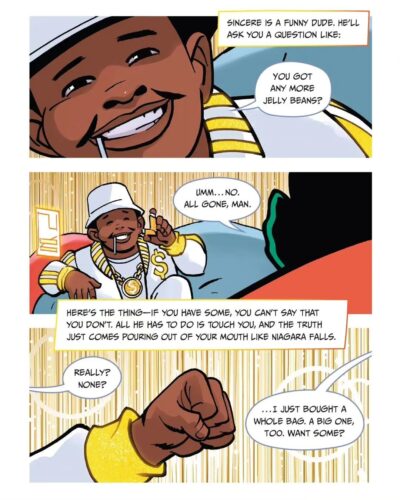Review of the Day: Like Lava In My Veins by Derrick Barnes, ill. Shawn Martinbrough with Adriano Lucas

Like Lava in My Veins
By Derrick Barnes
Illustrated by Shawn Martinbrough
Colors by Adriano Lucas
Nancy Paulsen Books (an imprint of Penguin Random House)
$18.99
ISBN: 9780525518747
On shelves July 4th
The superhero picture book is not a new idea. It’s been around for a couple decades at least. Right off the top of my head I can conjure up titles like The Adventures of Sparrowboy by Brian Pinkney (2000) or Superhero ABC by Bob McLeod (2006). Google “superhero picture books” sometime and you’ll get hit in the face by a plethora of them. Some of them just have superhero characters but maintain the format of your average bedtime book. Others go whole hog and put in panels and speech balloons and everything. And to this day each and every last one of those books is . . . well . . . perfectly fine. Not extraordinary. Not trying anything particularly new. The format, in many cases, is the hook. Kids like comics, right? So just put a picture book into a comic book format. The increased respect for comics these days plus the acknowledgement that kids younger and younger read them (the TOON Books imprint predicates its entire existence on that idea) PLUS the popularity of the Marvel films equals an immediate cash cow for any picture book that tries its hand at the form, right? Wrong. Look, when I say “perfectly fine” I’m basically saying that superhero/comic book-styled picture books are never all that interesting. And the only way to even attempt to make them interesting would be to have a really good writer pair their name to such a project. So far, in spite of the pedigree (remember Michael Chabon’s The Astonishing Secret of Awesome Man?) nobody’s ever really managed to bring great writing to the form.
Until now.
The name “Derrick Barnes” should, by all rights, be accompanied by angel choirs and a John Williams score. This is the man that managed to turn a poem like Crown: An Ode to the Fresh Cut into one of the most highly decorated picture book award winners of our age. He’s dabbled with some follow-ups, some early chapter books, and some first day of school books, but now he’s started flexing his muscles again. You get the sense that he understands that it’s time to try something both new and familiar. In Like Lava in My Veins you’ve a perfect melding of superhero tropes and topical contemporary issues. It’s a tricky balance, but by gum the man pulls it off in the end.
ADVERTISEMENT
ADVERTISEMENT

You know that kid that’s just full of so much fire he has a hard time controlling himself? Some injustice will happen and before you know it he’s lit up like a torch. Well, that’s Bobby Beacon (because “Beacons lead people and show them the way”) and he’s headed for AKWAA a.k.a. The Academy of Kids with Awesome Abilities. Once there, Bobby notices another new student named Pause getting kicked out after just a week for her behavior. Unfortunately, Bobby’s having some troubles as well. When his teacher continues to make him feel invisible in class, he just can’t control himself and ends up melting a chair. It looks like he might be on the road to joining The Institute of Supervillains, but then a change is made. Suddenly he’s in a class with a new teacher named Miss Brooklyn. She makes Bobby feel wanted, loves Langston Hughes as much as he does, and teaches him calming techniques to deal with the fire inside. Good thing too because before long Headmaster Chaos of the Institute has come to take Bobby away to his school, and it’ll take all our hero’s control and intelligence to keep his head and stand up for what’s right.
As I mentioned before, Barnes is a good writer. And when he’s on, he’s on. I don’t know why he wanted to write this book in particular, but I can speculate. Superheroes, by and large, are usually big wish fulfillment fantasies/metaphors (and that’s when they’re done right). Other picture books about kids that Barnes has done recently usually star kids with an already rock solid strong sense of self, appreciated by their family and community. In this respect, Bobby’s a bit of a departure for Barnes. He’s named himself “Bobby Beacon”, which indicates that he knows his own worth, but time after time there are people telling him who he is or what he can’t do. It’s only because he finds a strong supportive mentor in the school that Bobby’s able to tap back into that sense of self-worth (and just in time too). Barnes expertly weaves this familiar tale of a kid dismissed by the adults in his life alongside the more superpowered elements. As a result, the real and familiar elements root the fantasy, while the superhero stuff keeps the book from degrading into forgettable but well-intentioned moralizing. One would not stand well without the other.

Not that this is the only work Barnes is doing. There’s a lot more to pick apart here. For example, a significant moment in the text (and I missed this on a first read) is when Bobby defends his own name. At one point in the story the headmaster of the supervillain school has invaded AKWAA. As the students and teachers remain frozen, the headmaster call Bobby out, using the name “Lava Boy”. Yet Bobby chose that particular name, “Beacon”, for a reason and remembering that fact grounds him enough to stand up for it. The lesson that you take away from this book isn’t to just lie down and let people walk all over you. Rather, it’s that anger can be controlled and used to defend yourself when you’re under some kind of a threat. Anger isn’t wrong, a total loss of control is wrong. As Miss Brooklyn says, “Peace, be still.”
If this sounds like a lot of plot, backstory, and underlying messaging for a picture book, you’re not wrong. And you know what kids who read picture books also like to be read? Comics. It’s not like they distinguish between the two at first. They may not understand everything they read in comics but that mixing and melding of text and image is so enticing, isn’t it about time they had a book of their own that could match? I’ve always said that our kids deserve the rarest kind of best, and that goes double for comic-infused picture book fare. Plus, there are little moments in this book that I know parent and adult readers will appreciate. For example, I know it probably wasn’t a direct reference, but that moment when Bobby plugs his ears with paper so he can’t hear Pause’s voice? Suddenly I was reminded of Get Out and the moment when our hero plugs his ears with cotton so he won’t be knocked out too.

And now I’m going to tell you why folks are going to ban this book. Not everyone. Not almost anyone, even. But we live in an era where a book in which any plot that involves a Black kid tackling issues of built-in racist assumptions within a school setting is going to raise the hackles of certain ban-happy parents, right from the start. That’s not specifically why they’re going to ban it, though. They won’t even ban it because of the comic book elements or the fighting montages. No, they’re going to zero in on one particular character in the narrative. In the story, Bobby befriends a kid named Sincere. He’s this Run-DMC era cool kid with the power to make you tell the truth no matter what. He’s also featured sporting a golden inhaler as he sits in “The Chill Zone”. It is quite clearly an inhaler, and when I saw it I was impressed. I don’t know if it was Derrick or Shawn’s idea to add it to his character, but just the very act of not just normalizing an inhaler but making it look incredibly cool as well, that breaks down those age-old stereotypes of kids with asthma. I just know someone is going to appreciate its inclusion. Now how long, I ask you, will it be before someone looks at those images of Sincere and thinks the asthma inhaler is some kind of mini bong? I give complete credit to the creators of this book and the publisher for sticking to their guns and keeping that inhaler in there, knowing, as they must, that someone somewhere is going to clutch their pearls and misinterpret it according to their own prejudices. And now, let us hope with all our hearts, that I’m wrong about this.
Speaking of Sincere, there was one sequence involving his character that caught my eye, so we need to talk about the art on these pages. Artist Shawn Martinbrough makes a series of choices with the panels of this book that overall really pleased me. Paired alongside Adriano Lucas’s killer coloring, the pictures here just pop off the page. They feel centered, and not like they were retrofitted from a comic book to fit a picture book format. What I found particularly curious, though, were the moments when Martinbrough would duplicate a panel completely. This happens a couple times in the book. The first time I noticed it, it was during that initial discussion between Bobby and Sincere. The two pages are split into six panels. Two of the panels are almost identical close-ups of Sincere’s face (albeit with the lollipop in his mouth moving from one side to another). Two other panels involve his fist. The first panel shows him raising it to use his power against someone lying to him. The second shows that fist meeting up with Bobby’s in a fistbump. I liked this repetition since I thought it did a good job of showing a progression in the two kids’ friendship. Later, however, there’s a repetition of two panels that’s kind of baffling. It’s when Bobby asks the principal if Pause could be given another chance and added to Miss Brooklyn’s class. On two different pages the same panel is repeated of Miss Brooklyn, Pause, and Bobby, the only significant difference being the mask in Pause’s hands in the first panel and the speech balloons in the second. It really took me out of the read and was the only moment where I felt like the book just assumed the reader wouldn’t notice. But if a 45-year-old woman can notice that sort of thing then you can BET a five-year-old will. Those kids are merciless.
All told, the book’s a successful bit of experimentation. It’s got the meaningful storyline with real life antecedents. It also has a kid that can melt pavement to revenge himself against jerk bus drivers. I mean, what else do you need other than that? I mentioned before that superhero picture books are nothing new. I’ll stand by that statement, but here’s the truth of the matter. Good superhero picture books? As rare as sunflowers in May. This book stands out as one of the best of the best. And the kicker? Kids will actually love it too. How’s that for a notion?
On shelves July 4th.
Source: Final copy sent from publisher for review.
Filed under: Best Books, Best Books of 2023, Reviews, Reviews 2023
About Betsy Bird
Betsy Bird is currently the Collection Development Manager of the Evanston Public Library system and a former Materials Specialist for New York Public Library. She has served on Newbery, written for Horn Book, and has done other lovely little things that she'd love to tell you about but that she's sure you'd find more interesting to hear of in person. Her opinions are her own and do not reflect those of EPL, SLJ, or any of the other acronyms you might be able to name. Follow her on Twitter: @fuseeight.
ADVERTISEMENT
ADVERTISEMENT
SLJ Blog Network
2024 Books from Pura Belpré Winners
Winnie-The-Pooh | Review
Parsing Religion in Public Schools
Finding My Own Team Canteen, a cover reveal and guest post by Amalie Jahn
ADVERTISEMENT







